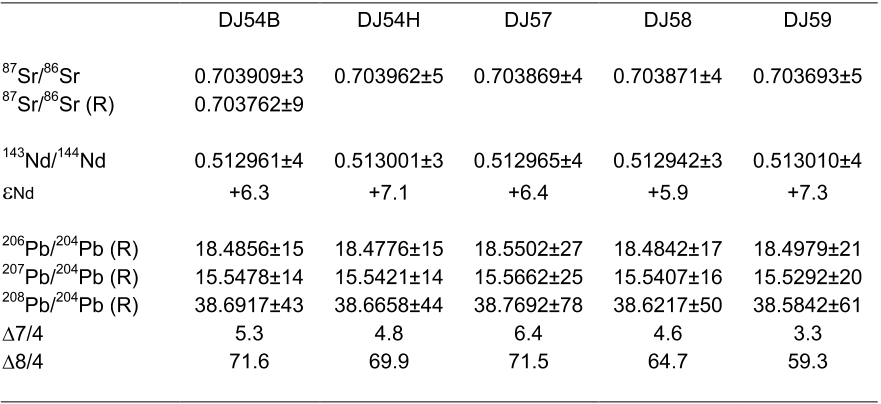A LREE-depleted component in the Afar plume; further evidence from Quaternary Djibouti basalts
Figures (8)

Table 2 (continued).4 5 
Table 2 (continued).4 5 
Table 3 Click here to download Table: Hayy_Table 3nb.doc 
Table 1. Unspiked 40K-40Ar datings of Hayyabley basalts. See text for the analytical 1 procedures. 2 3 
Table 1.5 
Table 4. Sr, Nd and Pb isotopic compositions of Hayyabley basalts (B: bulk rock; R: residue 1 after leaching). See text for the analytical procedures. Δ7/4 and Δ 8/4 denote the deviation (in 2 0/00) of 
Table 4. Sr, Nd and Pb isotopic compositions of Hayyabley basalts (B: bulk rock; R: residue 1 after leaching). See text for the analytical procedures. Δ7/4 and Δ 8/4 denote the deviation (in 2 0/00) of 
Table 3 Click here to download Table: Hayy_Table 3nb.doc
Citations
62 citations
Cites background from "A LREE-depleted component in the Af..."
...…Thirlwall et al., 2004; Kokfelt et al., 2006], the Galapagos [White et al., 1993;Hoernle et al., 2000; Blichert-Toft and White, 2001; Saal et al., 2007], Afar [Furman et al., 2006; Beccaluva et al., 2009; Daoud et al., 2010] and Hawaii [Yang et al., 2003; Frey et al., 2005; Fekiacova et al., 2007]....
[...]
46 citations
45 citations
42 citations
Cites background from "A LREE-depleted component in the Af..."
...Analogues of the Karelian Palaeoproterozoic continental MORB-type tholeiities have been recognized in the North Atlantic and Afar continental flood basalt provinces, where depleted MORB-type tholeiitic basalts are shown to have formed simultaneously with high-Ti basalts (Barrat et al., 2003; Daoud et al., 2010; S ager & Holm, 2011;Waight & Baker, 2012)....
[...]
..., 2012), and dikes (this study) compared with low-Ti tholeiites from the Faroe Islands (S ager & Holm, 2011), depleted basalts from Central East Greenland (Waight & Baker, 2012), LREE-depleted basalts from Central Afar (Barrat et al., 2003; Daoud et al., 2010), Kolbeinsey Ridge and Reykjanes Ridge basalts (PetDB), and global N-MORB (PetDB)....
[...]
...MORB-type continental tholeiitic basalts are thought to have formed as a result of melting of depleted mantle components in mantle-plume source regions (Daoud et al., 2010; S ager & Holm, 2011; Waight & Baker, 2012)....
[...]
..., 1990; Perttunen & Hanski, 2003); Fe^Ti basalts and low-Ti basalts, Faroe Islands (S ager & Holm, 2011); Fe^Ti basalts and depleted basalts, Central East Greenland (Waight & Baker, 2012); LREE-depleted basalts, Central Afar (Barrat et al., 2003; Daoud et al., 2010)....
[...]
References
306 citations
302 citations
"A LREE-depleted component in the Af..." refers background in this paper
...Origin of depleted 611 components in basalt related to the Hawaiian hot spot: Evidence from isotopic and 612 incompatible element ratios....
[...]
...Similar conclusions have been reached for the Hawaiian 418 (Frey et al., 2005) and Icelandic (Thirlwall, 1995; Kerr et al., 1995; Fitton et al., 1997; 419 Chauvel and Hémond, 2000; Thirlwall et al., 2004; Skovgaard et al., 2001; Kokfelt et al., 420 2006) plumes....
[...]
...…al., 1997; 49 Chauvel and Hémond, 2000; Skovgaard et al., 2001; Fitton et al., 2003; Thirlwall et al., 2004; 50 Kokfelt et al., 2006); (2) Hawaii (Chen and Frey, 1985; Yang et al., 2003; Frey et al., 2005); 51 (3) the Galapagos (White et al., 1993; Hoernle et al., 2000; Blichert-Toft and White,…...
[...]
...Trace element and isotope geochemistry of lavas from 543 Halaakala Volcano, East Maui: implications for the origin of Hawaiian basalts....
[...]
...However, the occurrence of subordinate components characterized by a light rare 47 earth element (LREE) depletion has been suggested from the study of basalts from major 48 mantle plumes in: (1) Iceland (Zindler et al., 1979; Hémond et al., 1993; Taylor et al., 1997; 49 Chauvel and Hémond, 2000; Skovgaard et al., 2001; Fitton et al., 2003; Thirlwall et al., 2004; 50 Kokfelt et al., 2006); (2) Hawaii (Chen and Frey, 1985; Yang et al., 2003; Frey et al., 2005); 51 (3) the Galapagos (White et al., 1993; Hoernle et al., 2000; Blichert-Toft and White, 2001; 52 Saal et al., 2007); and (4) the Kerguelen Archipelago (Doucet et al., 2002)....
[...]
280 citations
"A LREE-depleted component in the Af..." refers background or methods in this paper
...Their distinct locations, emplacement ages (Oligocene for E88, ca. 1 Ma for 363 Hayyabley and less than 0.2 Ma for Manda Hararo) and underlying crustal/lithospheric 364 thickness (normal for E88, thinned for the two other occurrences) are hardly consistent with a 365 similar petrogenetic history....
[...]
...…Afar basalts (Treuil and Joron, 1975; Joron et al., 295 1980; Deniel et al., 1994) are dominantly enriched, previous studies (Barrat et al., 1993, 2003; 296 Pik et al., 1999; Meshesha and Shinjo, 2007) have demonstrated that minor depleted 297 components were also involved in their petrogenesis....
[...]
...Compositions of LREE-depleted basalts from Hayyabley (average of the samples 846 analysed by ICP-MS), Manda Hararo (average data from Barrat et al., 2003), Ethiopian 847 Plateau (sample E88, Pik et al., 1999), and of a N-MORB from Tadjoura Gulf (sample A3D3, 848 Joron et al., 1980; Barrat et al., 1993)....
[...]
...Compositions of LREE-depleted basalts from Hayyabley (average of the samples 1 analysed by ICP-MS), Manda Hararo (average data from Barrat et al., 2003), Ethiopian 2 Plateau (sample E88, Pik et al., 1999), and of a N-MORB from Tadjoura Gulf (sample A3D3, 3 Joron et al., 1980; Barrat et al., 1993)....
[...]
...…et al., 1992), (3) Erta „Ale volcanics 821 (Barrat et al., 1998), (4) LREE-depleted basalts from Manda Hararo (MH, Barrat et al., 2003), 822 and (5) some Ethiopian samples (E88: depleted Oligocene basalt; HT2: average composition 823 of high-Ti basalts, Pik et al., 1999) are shown for comparison....
[...]
275 citations
"A LREE-depleted component in the Af..." refers background in this paper
...…by a light rare 47 earth element (LREE) depletion has been suggested from the study of basalts from major 48 mantle plumes in: (1) Iceland (Zindler et al., 1979; Hémond et al., 1993; Taylor et al., 1997; 49 Chauvel and Hémond, 2000; Skovgaard et al., 2001; Fitton et al., 2003; Thirlwall…...
[...]
264 citations